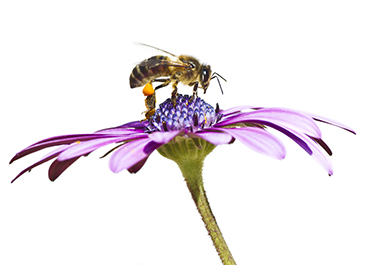Picture this: a backyard brimming with colourful flowers, tall stalks of wild grasses swaying gently in the breeze, the soft humming of bumble bees collecting pollen, children laughing as they blow dandelion seeds at floating butterflies. Now picture what’s actually happening in landscapes across North America—perfectly mown, sterile, mono-crop lawns with every dandelion sprayed with weed killer and an eerie silence from the lack of insects.
Due to a significant loss of native vegetation, insects like wild bees and butterflies are declining in record numbers in North America. Also to blame are neonicotinoid pesticides that are sprayed and used to treat seeds, like corn and soy. These types of pesticides are toxic to bees and record numbers were killed during the last corn planting seasons as a result of insecticide contaminated dust.
Health Canada’s Pest Management Regulatory Agency has concluded that “current agricultural practices related to the use of neonicotinoid treated corn and soybean seed are not sustainable. The PMRA intends to implement additional protective measures for corn and soybean production, and issued a Notice of Intent on September 13, 2013 outlining action to protect bees from exposure to Neonicotinoid pesticides”.
But that’s not the only thing that is going to save the bees and butterflies. It is imperative for all of us to rethink our unsustainable green lawns outside of our homes, businesses and even along our roadways. Not only do they require watering during a season when we are concerned about rainfall levels, but they provide no sustenance or habitat for the bees and butterflies. Instead, we need to support native vegetation, like milkweed, bergamot, goldenrod, foxglove and black eyed susans. This may require petitioning local businesses, government and transportation departments to leave insect forage and habitat unmown.
If the bees, our predominant pollinators, were to disappear, we would then lose eighty percent of the plants, including the majority of our food crops, like our fruit trees. Imagine BC with no apples! And don’t forget the birds—insects are also their primary source of food. The loss of any component of our ecosystem can have a catastrophic cascading effect.
But the simplest and most inspiring thing you can do right now: plant food and flowers! With spring almost upon us, we begin thinking about our gardens. Ensure the seeds you purchase are not treated with any pesticides. Choose native vegetation and consider species that flower at different times. Both bees and butterflies like nectar-producing flowers in yellow, pink, orange and purple colours—think crocuses, dahlias, lavender, berries and even squash. Even if you don’t have a garden, a patio still has room for flowers and herbs, even growing in pots. Get community-minded and join a shared garden or plant the roundabout on your street. Not only will the insects thank you, but you get to enjoy an outdoor space abuzz with colour and life!

